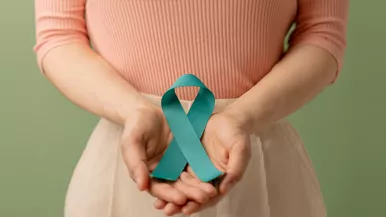More than 11,500 women are diagnosed with cervical cancer in the U.S. each year. And for some, it will be too late to receive effective treatment.
Cervical cancer is a slow-growing disease that rarely causes symptoms in its early stages.
And it’s almost always caused by the human papillomavirus — the most common sexually transmitted infection in the U.S.
Affecting approximately 72 million Americans, HPV can be detected in the vast majority of all cervical cancers.
“HPV is very common; up to 85% of people have been exposed at some point in their lives,” says Summer Dewdney, MD, a gynecologic oncologist at RUSH MD Anderson Cancer Center. “But the vast majority never develop any symptoms, and the body’s immune system can usually clear HPV on its own within a couple of years.”
In some women, however, certain strains of HPV cause changes to the cells in the cervix, which then can become cancerous.
Here, Dewdney offers five tips for reducing your risk of cervical cancer:
1. Get vaccinated.
“We have a vaccine for cancer,” Dewdney says. “Use it!”
HPV vaccines help protect against the types of HPV that cause most cervical cancers and other HPV-related cancers. Your doctor will discuss the dosing schedule with you. These are the recommendations for HPV vaccination, according to the Centers for Disease Control and Prevention:
- Two doses of an HPV vaccine for all adolescents at age 11 or 12 years.
- Teens and adults aged 13-26 who have not previously been vaccinated and have not previously been diagnosed with cervical cancer.
- For adults who are 27-46 years old, clinicians can consider HPV vaccination for those who would benefit.
“If you aren't eligible but your children are the right ages, consider taking them to be vaccinated,” Dewdney says. “If you are older and have never received the HPV vaccination, consider having a conversation with your provider about the risks and benefits of getting the vaccination series completed. But the best time to get the vaccine is when you are an adolescent.”
The CDC strongly recommends that adolescents be vaccinated before they are exposed to HPV. But even if you’ve already been infected with one or more HPV types, the vaccine can still protect you from other HPV types.
2. Get routine Pap tests.
Pap tests enable doctors to detect abnormalities — changes on the cells on your cervix — and take action before cervical cancer develops.
“Women should follow their doctors’ guidelines and get pap smears on a routine basis,” Dewdney says. “And any bleeding with intercourse should be evaluated by a gynecologist.”
According to the American Cancer Society, between 60% and 80% of women in the U.S. with newly diagnosed invasive cervical cancer have not had a Pap test in the past five years. And many of these women have never had the exam.
3. Follow up on abnormal Pap smears.
If the examination or your Pap test suggests something other than normal, your doctor will perform other tests to determine the problem.
In some cases where women had prior abnormal Pap test results, doctors may also perform an HPV test, which can detect HPV on a woman’s cervix.
4. Practice safe sex.
Condoms help to lower the risk of contracting HPV and developing HPV-related diseases, including cervical cancer.
“If you are sexually active, use a condom to prevent STIs,” Dewdney says. “Unprotected sex leaves you at risk for contracting sexually transmitted infections that can increase your risk of getting HPV and greatly increase your chances of developing precancerous changes of the cervix.”
But while condoms help to lower the risk of developing HPV-related diseases, including cervical cancer, HPV can infect areas that are not covered by a condom, so they may not fully protect against HPV. That’s why it’s essential to get the HPV vaccine in addition to using condoms.
5. Quit smoking.
Smoking cigarettes doubles your risk of developing cervical cancer. Studies have shown that tobacco by-products damage the DNA of cervix cells and may contribute to the development of cervical cancer.




